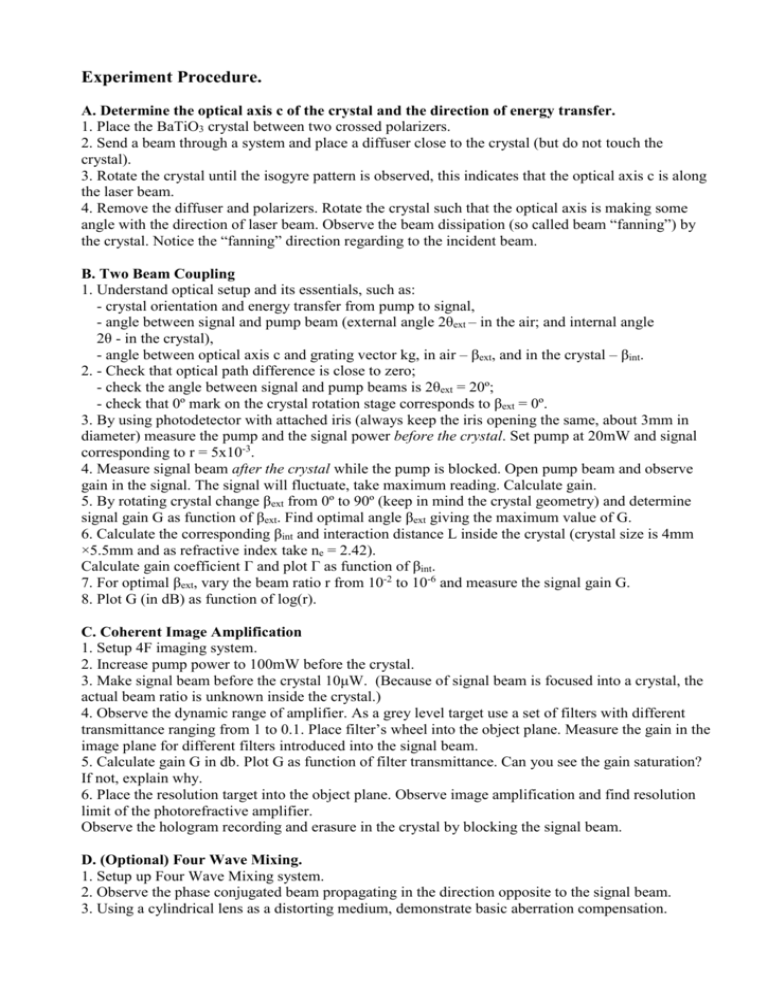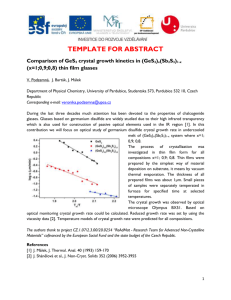Photorefraction/Dynamic Holography Experiment
advertisement

Experiment Procedure. A. Determine the optical axis c of the crystal and the direction of energy transfer. 1. Place the BaTiO3 crystal between two crossed polarizers. 2. Send a beam through a system and place a diffuser close to the crystal (but do not touch the crystal). 3. Rotate the crystal until the isogyre pattern is observed, this indicates that the optical axis c is along the laser beam. 4. Remove the diffuser and polarizers. Rotate the crystal such that the optical axis is making some angle with the direction of laser beam. Observe the beam dissipation (so called beam “fanning”) by the crystal. Notice the “fanning” direction regarding to the incident beam. B. Two Beam Coupling 1. Understand optical setup and its essentials, such as: - crystal orientation and energy transfer from pump to signal, - angle between signal and pump beam (external angle 2θext – in the air; and internal angle 2θ - in the crystal), - angle between optical axis c and grating vector kg, in air – βext, and in the crystal – βint. 2. - Check that optical path difference is close to zero; - check the angle between signal and pump beams is 2θext = 20º; - check that 0º mark on the crystal rotation stage corresponds to βext = 0º. 3. By using photodetector with attached iris (always keep the iris opening the same, about 3mm in diameter) measure the pump and the signal power before the crystal. Set pump at 20mW and signal corresponding to r = 5x10-3. 4. Measure signal beam after the crystal while the pump is blocked. Open pump beam and observe gain in the signal. The signal will fluctuate, take maximum reading. Calculate gain. 5. By rotating crystal change βext from 0º to 90º (keep in mind the crystal geometry) and determine signal gain G as function of βext. Find optimal angle βext giving the maximum value of G. 6. Calculate the corresponding βint and interaction distance L inside the crystal (crystal size is 4mm ×5.5mm and as refractive index take ne = 2.42). Calculate gain coefficient Γ and plot Γ as function of βint. 7. For optimal βext, vary the beam ratio r from 10-2 to 10-6 and measure the signal gain G. 8. Plot G (in dB) as function of log(r). C. Coherent Image Amplification 1. Setup 4F imaging system. 2. Increase pump power to 100mW before the crystal. 3. Make signal beam before the crystal 10μW. (Because of signal beam is focused into a crystal, the actual beam ratio is unknown inside the crystal.) 4. Observe the dynamic range of amplifier. As a grey level target use a set of filters with different transmittance ranging from 1 to 0.1. Place filter’s wheel into the object plane. Measure the gain in the image plane for different filters introduced into the signal beam. 5. Calculate gain G in db. Plot G as function of filter transmittance. Can you see the gain saturation? If not, explain why. 6. Place the resolution target into the object plane. Observe image amplification and find resolution limit of the photorefractive amplifier. Observe the hologram recording and erasure in the crystal by blocking the signal beam. D. (Optional) Four Wave Mixing. 1. Setup up Four Wave Mixing system. 2. Observe the phase conjugated beam propagating in the direction opposite to the signal beam. 3. Using a cylindrical lens as a distorting medium, demonstrate basic aberration compensation.








